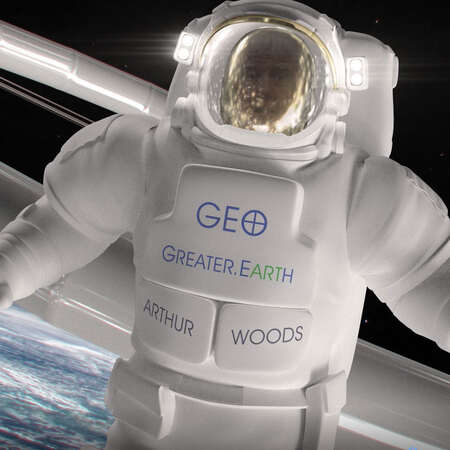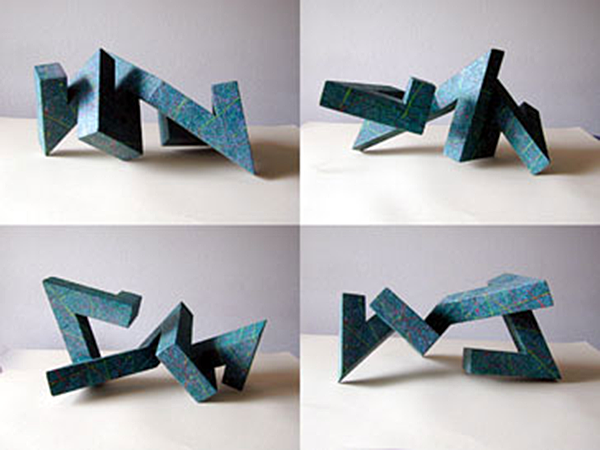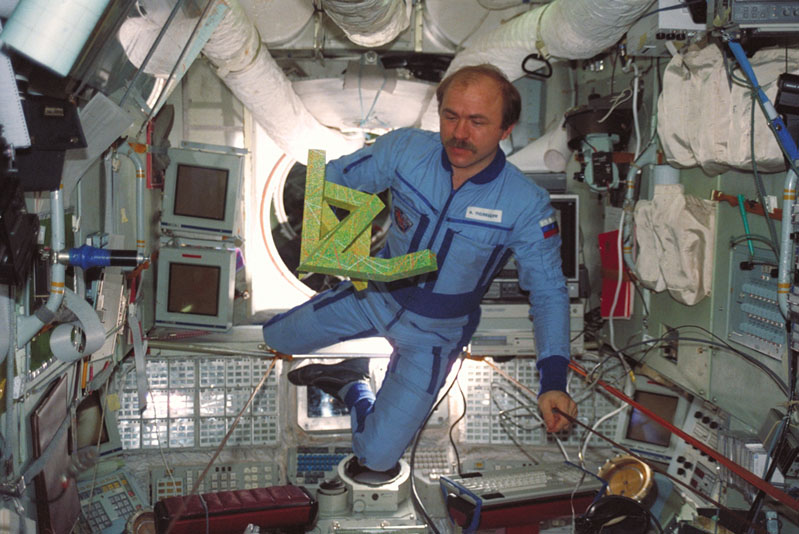
Switzerland
Art and Gravity
My interest in space and physics had a major influence on my art, especially on my approach to painting. I learned that gravity on Earth has to do with the force that the acceleration of Earth imparts to objects on or near its surface. Gravity, as a terrestrial environmental factor, may hardly be considered as essential to the creation of art, yet it has profoundly influenced and determined both the conception and the perception of art since its beginnings.
Basically gravity gives us an “up and down” orientation to the environment in which we live. Therefore, paintings, particularly those with a rectangular shape usually have a “natural” top and bottom orientation because this reflects how the viewer and the artist perceive the world we live in.
I began to explore how gravity influenced my painting with a series of works that had a six-sided geometric shape.
These two-dimensional works could then be mounted on a wall in any position as there was no natural “top or bottom” orientation. The shading of some the triangular areas created by the intersections of the lines, added a perceptual component to the works which created a three-dimensional effect. How the work was positioned imparted a specific uniqueness to its perception as seen in the images of the same painting below.
Sculpture and Gravity
Because they are created in a terrestrial environment, all sculptures have a "resting point" - a point of contact in which their mass interacts with the gravity of the Earth. Sometimes sculptures are fixed to a base so that their appearance seems natural in our gravity dominated environment. Others stand, rest or are fixed to some supporting structure. Even "balloon" or air-filled sculptures that may float in the air are positioned by the force of gravity.
Consciously or unconsciously, artists conceive and carry out their sculptural creations with gravity determining the eventual resting point of the work, and, by so doing, they pre-determine how the sculpture will eventually be perceived and appreciated by the public. Thus the influence of gravity has much to do with our perception and appreciation of sculpture - as our response to its aesthetic "rightness" is based on our own experiences within the terrestrial environment.
I applied these ideas and my painting technique to a series of three-dimensional geometrically shaped objects I call Cosmic Dancers.
The geometric form of these sculptures enabled them to be positioned in different ways. This aspect allowed the sculptures to be viewed from different perspectives and, in relation to their surroundings, the same sculpture could appear as a unique three dimensional form as a result of its varied positions. Depending on the geometric complexity, usually between four and eight resting positions could be found for each sculpture and its interaction with gravity i.e. - its resting point - being the ultimate determining factor.
When imagining human civilization extended into outer space, it seems obvious that the art of this civilization will take advantage of its new environment. Much like the influence of gravity has had on the evolution of terrestrial art , the qualities specific to the space environment will have a fundamental effect on both the conception and perception of the artworks designed and realized there. In the zero-gravity (zero-G) or micro-gravity environments of outer space, the influence of gravity disappears and artworks become weightless. As a consequence, the conception, perception and appreciation of an artwork will be altered. For example, a sculpture floating in a zero-G environment can be viewed from an infinite number of perspectives or angles – something that is not normally possible in a typical art setting on Earth.
On May 22, 1993, I sent the Cosmic Dancer sculpture to the Russian Mir space station to investigate the properties of sculpture in weightlessness and to evaluate the integration of art into the human space program. The Cosmic Dancer - a painted geometric form made out of welded aluminum tubing measuring approximately 35 x 35 x 40 centimeters and weighing exactly one kilogram - was the first three-dimensional artwork to be specifically conceived for and officially realized in a space habitat.
cosmicdancer.com
Inflatable Technologies for Sculpture in Earth Orbit
Art to the Stars - an Astronautical Perspective on the Arts and Space
My interest in space and physics had a major influence on my art, especially on my approach to painting. I learned that gravity on Earth has to do with the force that the acceleration of Earth imparts to objects on or near its surface. Gravity, as a terrestrial environmental factor, may hardly be considered as essential to the creation of art, yet it has profoundly influenced and determined both the conception and the perception of art since its beginnings.
Basically gravity gives us an “up and down” orientation to the environment in which we live. Therefore, paintings, particularly those with a rectangular shape usually have a “natural” top and bottom orientation because this reflects how the viewer and the artist perceive the world we live in.
I began to explore how gravity influenced my painting with a series of works that had a six-sided geometric shape.

Acrylic on Canvas, 120 x 150 cm
These two-dimensional works could then be mounted on a wall in any position as there was no natural “top or bottom” orientation. The shading of some the triangular areas created by the intersections of the lines, added a perceptual component to the works which created a three-dimensional effect. How the work was positioned imparted a specific uniqueness to its perception as seen in the images of the same painting below.
Sculpture and Gravity
Because they are created in a terrestrial environment, all sculptures have a "resting point" - a point of contact in which their mass interacts with the gravity of the Earth. Sometimes sculptures are fixed to a base so that their appearance seems natural in our gravity dominated environment. Others stand, rest or are fixed to some supporting structure. Even "balloon" or air-filled sculptures that may float in the air are positioned by the force of gravity.
Consciously or unconsciously, artists conceive and carry out their sculptural creations with gravity determining the eventual resting point of the work, and, by so doing, they pre-determine how the sculpture will eventually be perceived and appreciated by the public. Thus the influence of gravity has much to do with our perception and appreciation of sculpture - as our response to its aesthetic "rightness" is based on our own experiences within the terrestrial environment.
I applied these ideas and my painting technique to a series of three-dimensional geometrically shaped objects I call Cosmic Dancers.
The geometric form of these sculptures enabled them to be positioned in different ways. This aspect allowed the sculptures to be viewed from different perspectives and, in relation to their surroundings, the same sculpture could appear as a unique three dimensional form as a result of its varied positions. Depending on the geometric complexity, usually between four and eight resting positions could be found for each sculpture and its interaction with gravity i.e. - its resting point - being the ultimate determining factor.
Reclining Dancer
Acrylic on Wood, 25 x 28 x 57 cm
When imagining human civilization extended into outer space, it seems obvious that the art of this civilization will take advantage of its new environment. Much like the influence of gravity has had on the evolution of terrestrial art , the qualities specific to the space environment will have a fundamental effect on both the conception and perception of the artworks designed and realized there. In the zero-gravity (zero-G) or micro-gravity environments of outer space, the influence of gravity disappears and artworks become weightless. As a consequence, the conception, perception and appreciation of an artwork will be altered. For example, a sculpture floating in a zero-G environment can be viewed from an infinite number of perspectives or angles – something that is not normally possible in a typical art setting on Earth.
Cosmonaut Alexander Polischuk and the Cosmic Dancer on the Mir space station, 1993
On May 22, 1993, I sent the Cosmic Dancer sculpture to the Russian Mir space station to investigate the properties of sculpture in weightlessness and to evaluate the integration of art into the human space program. The Cosmic Dancer - a painted geometric form made out of welded aluminum tubing measuring approximately 35 x 35 x 40 centimeters and weighing exactly one kilogram - was the first three-dimensional artwork to be specifically conceived for and officially realized in a space habitat.
cosmicdancer.com
Inflatable Technologies for Sculpture in Earth Orbit
Art to the Stars - an Astronautical Perspective on the Arts and Space

